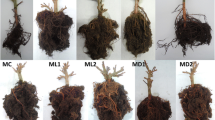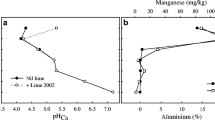Summary
An acid mine spoil in Southern Indiana was amended with lime (CaCO3) (0.0, 12.5, 25 and 39t/ha) and planted withElaegnus umbellata Thunb.,Alnus glutinosa Gaertn.,Robinia pseudoacacia L.,Robinia fertilis Ashe, ‘Arnot’,Myrica pensylvania Lois,Caragana arborescens L. andShepherdia argentea Nutt. Survival and soil data were collected periodically and plants were harvested 15 months after planting. Nodule and top dry weights were determined and acetylene reduction assays performed on the nodules.
Addition of lime caused significant increases in pH, and 39 t/ha of lime were required to maintain a pH above 5.5. Survival of plant material was greatest at the highest lime addition, although response of individual species varied.Elaeagnus umbellata, R. pseudoacacia, R. fertilis ‘Arnot’, andA. glutinosa appeared more tolerant of the harsh conditions. OnlyC. arborescens showed a linear increase in top dry weight due to lime addition.Alnus glutinosa andS. argentea achieved statistically the same growth regardless of pH, andR. fertilis ‘Arnot’ andE. umbellata did not increase in top dry weight above an addition of 25 t/ha.Robinia pseudoacacia achieved maximum top dry weight at 25 t/ha, whereasM. pensylvanica growth declined with increasing pH. Nodule dry weights increased with increasing pH; however,S. argentea showed greater nodule dry weights at lower lime levels. Acetylene reduction rates increased with lime addition.Elaegnus umbellata did not respond above 25 t/ha lime, whereasA. glutinosa did not show an increase until this point.
Similar content being viewed by others
References
Anonymous 1974 Handbook on Reference Methods for Soil Testing. Council on Soil Testing and Plant Analysis, Athens, Georgia, 68 p.
Armiger W A, Jones J N and Bennett O L 1976 Revegatation of land disturbed by stripmining of coal in Appalachia. ARS-NE 71, U.S.D.A. Agric. Res. Serv., Washington, DC, 38 p.
Becking J H 1975 Root nodules in non-legumes. pp 506–566In The Development and Function of Roots. Eds E J Torrey and D Clarkson. Academic Press. New York.
Bond G 1957 Isotopic studies of nitrogen fixation in nonlegume root nodules. Ann. Bot. 21, 373–380.
Bond G 1957 The development and significance of the root nodules ofCasuarina. Ann. Bot. 21, 373–380.
Bond G, Fletcher W W and Ferguson 1954 The development and function of the root nodules ofAlnus, Myrica andHippophae. Plant and Soil 5, 309–323.
Boyer S G and Mertz R W 1950 Tree species recommended for strip mine plantations in western Kentucky. Cent. For Exp. Sta. Tech. Paper 160, Columbus, Ohio, 32 p.
Brown J H 1973 Height growth prediction for black locust on surface-mined areas in W. Virginia. W. Va. Univ. Agr. Ext. Sta. Bull. 619. Morgantown, W. Virginia, 25 p.
Caniza A and Rodrigueq-Barrueco C 1976 Induction, of root nodules ofCoriaria myrifolia L. growing in water culture. N. Z. J. Bot. 14, 271–274.
Carpenter P L and Hensley D L 1979 Utilizing N2-fixing woody plant species for distressed soils. Bot. Gaz. 140, 76–81.
Dart P J 1975 Legume root nodule initiation and development. pp 467–506.In The Development and Function of Roots. Eds. E J Torrey and D Clarkson. Academic Press, New York.
Dean F W 1925 The reclamation of stripped coal lands. J. For. 23, 677–682.
Finn R F 1955 Ten years of strip-mine reforestation research in Ohio. Div. of Forest Mangt. Res. Report. Cent. States For. Expt. Station, Athens, Ohio, 23 p.
Funk D T 1974 Growth and development of older plantings on Ohio stripmine banks. pp 483–491.In Ecology and Reclamation of devastated Land. Eds. R. Hutnik and G Davis. Gordon and Breach, New York.
Gardner I C 1958 Nitrogen fixation inElaegnus root nodules. Nature London 818, 717–718.
Gardner I C and Bond G 1957 Observations on the root nodules ofShepherdia. Can. J. Bot. 35, 305–314.
Gaskins M H and Carter J L 1975 Nitrogenase activity: A review and evaluation of assay methods. Soil Crop Sci. Soc. Florida Proc. 35, 10–16.
Gibson A H 1977 The influence of the environment and managerial practices on the legume-Rhizobium symbiosis. pp 393–401In A Treatise on Dinitrogen Fixation, section IV. Agronomy and Biology. Eds. R W F Hardy and A H Gibson. John Wiley and Sons, New York.
Hoppel R E and Wollum, II, A G 1971 Histological studies of ectomycorrhizae and root nodules fromCercocarpus montanus andCercocarpus pauriaentatus. Can. J. Bot. 38, 1315–1318.
Munns D N 1970 Nodulation ofMedicago sativa in solution culture, V. Ca and pH requirements during infection. Plant and Soil 32, 90–102.
Munns D N 1977 Mineral nutrition and the legume symbiosis. pp 353–391In A Treatise on Dinitrogen Fixation. Section IV. Agronomy and Botany. Eds. R W F Hardy and A H Gibson. John Wiley and Sons, New York.
Munns D N and Fox R L 1976 Depression of legume growth by liming. Plant and Soil 45, 701–705.
Munns D N and Fox R L 1977 Comparative lime requirements of tropical and temperate legumes. Plant and Soil 46, 533–548.
Munns D N, Fox R L and Koch B L 1977 Influence of lime on nitrogen fixation by tropical and temperate legumes. Plant and Soil 46, 591–601.
Philpotts H 1976 Effect of lime on nodulation, growth and nutrient content ofTrifolium subterraneum on the far north coast of New South Wales. J. Aust Inst. Agric. Sci. 3, 238–241.
Plass W T 1975 An evaluation of trees and shurbs for planting surface-mine spoils. N E For. Expt. Stn. Res. Paper NE-317, Upper Darby, Pennsylvania, 8 p.
Struthers P H and Vimmerstedt J P 1965 Rapid strip mine reclamation. Ohio Report 50, 85–87.
Sutton P 1968 Soil conservation service plant materials tested at the eastern Ohio resource development center on coal mine spoil bank. Spec. Report. Ohio Agr Res. and Dev. Center, Wooster, Ohio. 6 p.
Sutton P 1970 Restoring productivity to coal mine spoil banks. Ohio Report 55, 62–63.
Sutton P 1970 Reclamation of toxic coal mine spoil banks. Ohio Report 55, 99–100.
Sutton P and Vemmerstedt J P 1973 Treat strip mine spoils with sewage sludge. Ohio Report 58, 121–123.
Author information
Authors and Affiliations
Rights and permissions
About this article
Cite this article
Hensley, D.L., Carpenter, P.L. Effect of lime additions to acid strip-mine spoil on survival, growth and nitrogen fixation (acetylene reduction) of several woody legume and actinomycete-nodulated species. Plant Soil 79, 353–367 (1984). https://doi.org/10.1007/BF02184328
Received:
Issue Date:
DOI: https://doi.org/10.1007/BF02184328




